| Mom came out to visit in September
2002 and I decided that she could see all the mountains she wanted in New
Hampshire but never any desert. Thatís why we drove right past the gorgeous
northern mountains of Colorado to get to Dinosaur. It had been almost exactly
a year to the day that I left Dinosaur after spending all summer working
there. That was a sunny Friday in late September and I drove out at 12
noon under a blue sky and brilliant sun with the sunroof down and the rock
n roll blaring. What a day. Now I was back. The journey wasnít easy, however.
In North Park we hit a patch of ice and the car spun 450 degrees before
grinding off the left side of the road about 20 feet, raking up sagebrush,
bunchgrass and lots of mud but amazingly, inflicting no damage on the car.
After that mishap I slowed down considerably, not knowing what lay up ahead,
and it took us most of the day to travel the typical 5 hour drive.
The evening was coming on as I drove up the Harperís Corner road and pulled into a little BLM campsite that Iíve spent many nights at. With the sun went the heat and the cold descended as if it came straight from outer space. We quickly put the tent up under a canopy of low pinyon pine and threw in our gear. It was cold enough that we just skipped dinner and went right to sleep. The next morning we got up around dawn and decided to go hiking right off rather than waste time preparing food for breakfast. I led her on the route I had so enjoyed the year before along the edge of the mesa near Plug Hat Butte and around to the north end where it drops down into a narrow slot canyon whose end Iíve never reached. It had rained only days before and the soil in the canyon was gumbo and stuck to shoes like glue. I mustíve collected 6 inches of mud on the soles of my boots within ten steps. I had to frequently stop and locate a good sharp-edged rock to scrape off the gunk. Nevertheless we continued on into the cool, dark crack of the canyon and meandered next to a trickle of water that curved along a smooth rock channel at the very bottom. We would have gone quite far, since the day was gorgeous and the scenery equally so, except that Mom developed strange physical ailments that may have been some form of dehydration/altitude sickness. At any rate she nearly passed out and felt cold and chilled, though it was fairly warm. We stopped and she rested, then we turned back and slowly made our way back to camp. She had to sit and rest ever so often. We finally made it back to camp and she had some water and food and that seemed to help. Later, when we were back in Fort Collins I showed her a photograph of the canyon we were in that I had taken on a much longer hike into itís depth last year. She was very disappointed that she did not get to see the area depicted in the photograph. 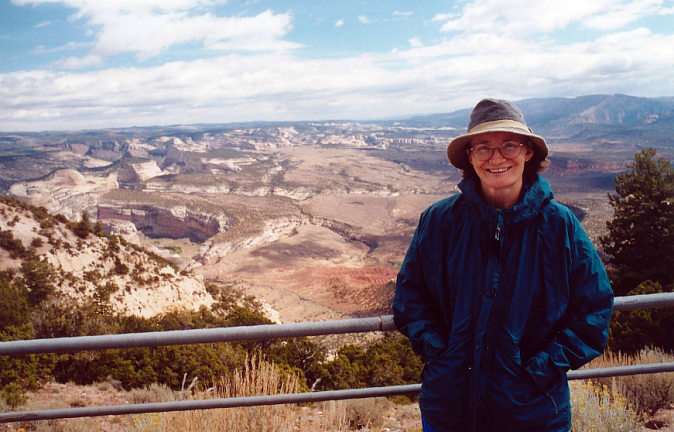 We set up camp in a shaded sandy clearing surrounded by box elders at the juntion of Jones and Ely Creeks. After everything was setup and stowed, we hiked the short bit up to Ely Falls. Upon returning, we cooked dinner and sat around, enjoying the silence broken only by the crisp multi-toned chatter of Joneís Creek nearby. At dusk we took a hike downstream, but did not make it all the way to the Green River. Thatís another trip. The evening did not cool off as much as it had the night before.  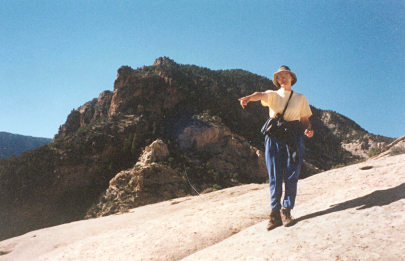
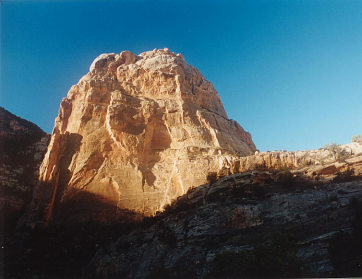 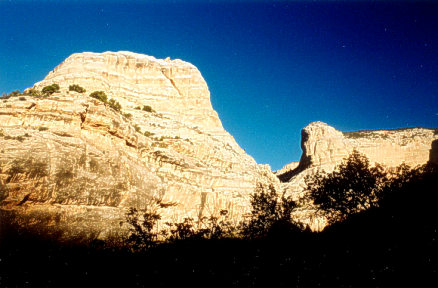 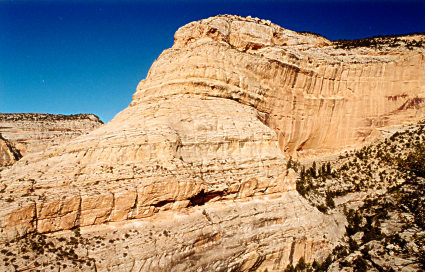 We spent a lot of time on top of the mesa, walking to all sides and sitting to admire the views. I had been here before with Dave but it was no less exciting to see the familiar pillars and walls again. I imagine that sometime around my 80th birthday Iíll be back at that same spot, and it will look exactly the same. I hope it does. After several hours we headed down. Despite my careful attention to our upward route, I missed the right crack to shimmy down on the way back and we got sidetracked. This turned out to be serendipitous as we found a group of very secluded petroglyphs. It is interesting to imagine that there once was a people who called this place home. Better than my home. And they have been called ďsavagesĒ? Back at camp, we threw everything into our packs and hiked uptrail along the rushing water, encountering nobody. We had a quick lunch at the trailhead, then drove back quickly under a sunny sky to Fort Collins in time to meet Andra for dinner at Cazzollaís. 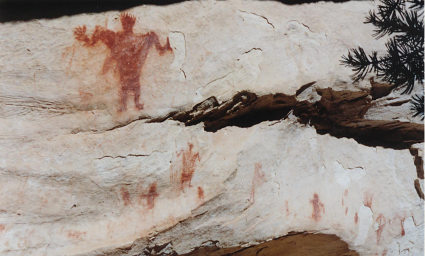
Back to Camping Next Send Comments |
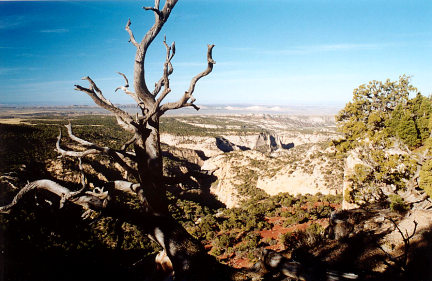 Mom
had been through the desert once, in New Mexico and Arizona, about 17 years
ago. Thus, the sinewy sandstone ridges and stark, spacious landscape that
inspires even those of us lucky enough to visit on a routine basis to redouble
our contributions to the Sierra Club, simply amazed her. I wonder if there
is anyplace on earth quite like it. Temperate and tropical forests seem
to me to look much the same no matter where you go, but Americaís western
desert...what a place. You feel like you should be required to show a passport
just to enter, and perhaps the great state of Utah wouldnít be against
such an idea, but thatís beside the point. The wide expanse of rock and
juniper and blue sky that stretches so far you can feel the curvature of
the atmosphere as it is pulled down to the round surface of the planet
shuts anyoneís yapper real quick. People just watch the hills as if they
were watching elephants on parade, with a keen interest usually shown only
to animate objects. Everything here is worth a second and third look.
Mom
had been through the desert once, in New Mexico and Arizona, about 17 years
ago. Thus, the sinewy sandstone ridges and stark, spacious landscape that
inspires even those of us lucky enough to visit on a routine basis to redouble
our contributions to the Sierra Club, simply amazed her. I wonder if there
is anyplace on earth quite like it. Temperate and tropical forests seem
to me to look much the same no matter where you go, but Americaís western
desert...what a place. You feel like you should be required to show a passport
just to enter, and perhaps the great state of Utah wouldnít be against
such an idea, but thatís beside the point. The wide expanse of rock and
juniper and blue sky that stretches so far you can feel the curvature of
the atmosphere as it is pulled down to the round surface of the planet
shuts anyoneís yapper real quick. People just watch the hills as if they
were watching elephants on parade, with a keen interest usually shown only
to animate objects. Everything here is worth a second and third look.